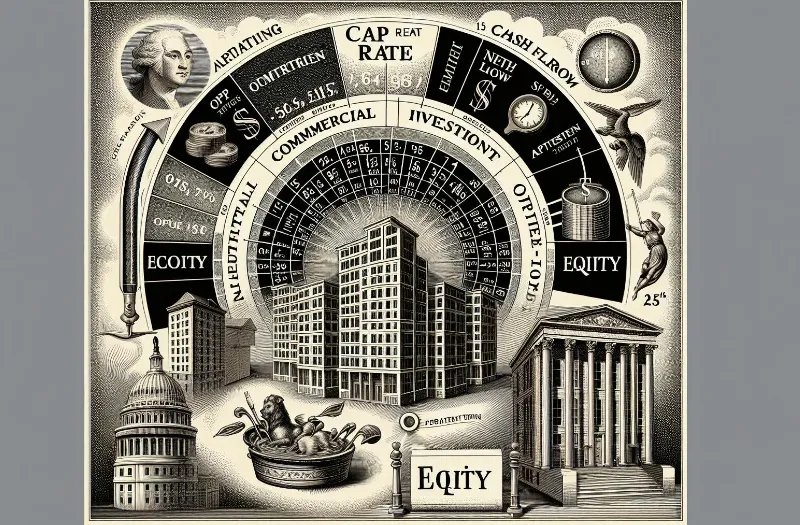Multifamily Investing Terminology: Your Comprehensive Guide to Key Terms and Jargon

Navigating the multifamily investing landscape can feel like decoding a complex language.
The jargon used by industry professionals can be daunting for newcomers and even those with some experience.
However, grasping the essential terms and concepts will empower you to make informed decisions and maximize your investment potential.
This article will break down the most common terms used in multifamily investing, providing detailed explanations, calculations, and practical applications to help you better understand this dynamic field.
1. Cash Flow
Definition: Cash flow is the total net income generated from a property after all operating expenses and mortgage payments have been deducted.
It is a vital measure of a property’s financial health.
How to Calculate:
- Total Income: All sources of income (rent, fees).
- Total Expenses: Operating costs (maintenance, property management, insurance, taxes).
Formula:
Cash Flow = Total Income - Total Expenses
Usage: Positive cash flow indicates that a property is generating more income than it costs to operate, which is crucial for financial stability and future investment opportunities.
2. Capitalization Rate (Cap Rate)
Definition: The cap rate is a ratio that helps investors assess the potential return on an investment property, allowing for quick comparisons between different opportunities.
How to Calculate:
- Net Operating Income (NOI): The income generated from the property after operating expenses.
Formula:
Cap Rate = NOI / Current Market Value
Usage: A higher cap rate signifies a potentially more profitable investment. It helps investors evaluate risk vs. reward and gauge the competitiveness of the property market.
3. Net Operating Income (NOI)
Definition: NOI is the total revenue from a property minus all operating expenses, providing insight into the property's profitability.
How to Calculate:
- Total Income: All income generated from the property.
- Operating Expenses: Excludes mortgage payments and capital expenditures.
Formula:
NOI = Total Income - Operating Expenses
Usage: NOI is a key metric used in determining cap rates and assessing cash flow, and it guides investors in understanding the financial performance of their property.
4. Debt Service Coverage Ratio (DSCR)
Definition: DSCR measures a property’s ability to cover its debt obligations (loan payments) based on the income it generates.
How to Calculate:
- Debt Service: The total of principal and interest payments due on a loan.
Formula:
DSCR = NOI / Debt Service
Usage: A DSCR greater than 1 indicates that the property generates enough income to pay its debts, which is crucial for securing financing and managing risk.
5. Return on Investment (ROI)

Definition: ROI is a performance measure used to evaluate the efficiency or profitability of an investment, expressed as a percentage.
How to Calculate:
- Net Profit: Total income minus total costs.
Formula:
ROI = (Net Profit / Cost of Investment) x 100
Usage: ROI provides insight into the effectiveness of your investment strategies and helps compare multiple investment opportunities based on expected returns.
6. Gross Rent Multiplier (GRM)
Definition: GRM is a simplified metric used to assess the potential value of an income-producing property relative to its gross rental income.
How to Calculate:
- Gross Annual Rent: Total potential rental income.
Formula:
GRM = Property Price / Gross Annual Rent
Usage: While GRM allows for rapid assessments of properties, it is a preliminary measure that should be supplemented with more detailed analyses.
7. Vacancy Rate
Definition: The vacancy rate represents the percentage of available rental units that are unoccupied, impacting overall income.
How to Calculate:
- Total Units: All rental units in the property.
Formula:
Vacancy Rate = (Vacant Units / Total Units) x 100
Usage: A high vacancy rate may indicate problems with the property, such as poor management or undesirable location, affecting potential cash flow.
8. Operating Expenses
Definition: Operating expenses encompass all costs associated with managing and maintaining a property, excluding mortgage payments.
Components Include:
- Maintenance and repair costs
- Property management fees
- Insurance premiums
- Property taxes
- Utilities
Usage: Accurately estimating operating expenses is crucial for calculating NOI and cash flow, allowing investors to assess the property’s profitability.
9. Property Management
Definition: Property management involves the administration and oversight of residential or commercial properties to ensure they are run efficiently and effectively.
Functions Include:
- Tenant screening and leasing
- Rent collection and accounting
- Property maintenance and repairs
- Handling tenant complaints and issues
Usage: Engaging a qualified property management company can enhance tenant satisfaction and retention, ultimately increasing the property’s profitability.
10. Equity
Definition: Equity is the ownership interest in a property, calculated by subtracting outstanding mortgage balances from the property’s market value.
How to Calculate:
Formula:
Equity = Current Market Value - Total Liabilities
Usage: Understanding equity is essential for financial planning, refinancing, or selling the property to unlock cash for future investments.
11. Market Value
Definition: Market value is the estimated price at which a property would sell on the open market, determined by various factors, including location, condition, and demand.
Usage: Knowing the market value helps investors make informed decisions regarding buying, selling, and financing properties, as well as understanding appreciation trends.
12. Lease Terms
Definition: Lease terms outline the conditions and rules governing the rental agreement between a landlord and tenant, including length, rent amount, and responsibilities.
Common Components:
- Duration of the lease
- Rent payment schedules
- Tenant responsibilities for maintenance
- Clauses for renewing or terminating the lease
Usage: Clear and well-defined lease terms help mitigate disputes and clarify expectations for both parties, contributing to successful landlord-tenant relationships.
13. 1031 Exchange
Definition: A 1031 exchange allows investors to defer capital gains taxes on the sale of an investment property by reinvesting the proceeds in a like-kind property.
Usage: Utilizing a 1031 exchange can significantly enhance an investor’s ability to grow wealth through real estate while minimizing tax liability, making it a favored strategy for savvy investors.
14. Appreciation
Definition: Appreciation refers to the increase in a property’s value over time due to factors such as market demand, improvements, and economic conditions.
Factors Influencing Appreciation:
- Location desirability
- Local market trends
- Economic growth
Usage: Understanding appreciation trends helps investors make informed decisions about long-term investment strategies and potential exit plans.
15. Diversification
Definition: Diversification is an investment strategy that involves spreading investments across various asset types to minimize risk.
Application: Investors can diversify within multifamily properties by investing in different types, such as Class A, B, and C properties or various geographical locations.
Usage: A well-diversified portfolio can help mitigate risks associated with economic fluctuations and real estate market downturns.
16. Financing
Definition: Financing refers to the various methods by which an investor acquires funds to purchase a property, often involving loans or other debt instruments.
Common Financing Types:
- Conventional mortgages
- Hard money loans
- Seller financing
Usage: Understanding financing options allows investors to select the most suitable funding methods for their investment strategies and risk profiles.
17. Exit Strategy
Definition: An exit strategy is a pre-planned approach for selling or disposing of an investment, determining how an investor will realize profits.
Common Strategies Include:
- Selling the property outright
- Refinancing to withdraw equity
- Converting the property to a different use or market
Usage: Developing a clear exit strategy helps investors make informed decisions at various points in the investment cycle and maximize returns.
18. Market Analysis
Definition: Market analysis entails evaluating a specific real estate market to identify trends, opportunities, and risks.
Key Components:
- Comparative sales analysis
- Rental price trends
- Demographic and economic factors
Usage: Conducting a thorough market analysis guides investors in identifying high-potential investment opportunities and aligning strategies with market conditions.
19. Syndication
Definition: Syndication is a partnership model wherein multiple investors pool resources to acquire a property that may be too large or expensive for individual investment.
Usage: Syndication allows smaller investors to access larger multifamily deals while sharing risks and returns, enabling greater portfolio diversification.
20. Yield
Definition: Yield is a financial term that indicates the income return on an investment, typically expressed as a percentage of the investment's cost.
How to Calculate:
Formula:
Yield = Annual Income / Property Value
Usage: Yield helps investors evaluate the attractiveness of various investment opportunities and assists in informed decision-making.
21. Tenant Improvement (TI)
Definition: Tenant improvements refer to modifications or upgrades made to rental spaces to accommodate tenants' needs and preferences.
Examples Include:
- Remodeling or refurbishing spaces
- Upgrading fixtures and finishes
- Adding custom elements for tenant requirements
Usage: Effective tenant improvements can enhance tenant satisfaction and retention rates, thus increasing the overall value of the property.
22. Leverage
Definition: Leverage involves using borrowed capital to increase the potential return on an investment. It allows investors to control larger assets with a smaller amount of their own capital.

Risks and Benefits:
- Benefits: Amplified potential returns on investment.
- Risks: Increased vulnerability to market fluctuations, potentially resulting in greater losses.
Usage: Investors need to balance the use of leverage carefully, as excessive borrowing can lead to financial distress, while moderate use can enhance investment outcomes.
23. Class A, B, C Properties
Definition: Properties are typically categorized into different classes based on their quality, location, and amenities, influencing their investment potential.
Class Descriptions:
- Class A: High-quality properties located in desirable areas; usually new or recently renovated with luxury amenities.
- Class B: Good quality properties that may require some upgrades; typically located in stable neighborhoods.
- Class C: Older properties in less desirable areas; often in need of significant repairs or renovations.
Usage: Understanding property classification helps investors align their risk profiles with investment strategies and anticipate potential returns.
24. Financing Costs
Definition: Financing costs encompass all expenses related to acquiring financing for a property, affecting overall investment returns.
Common Costs Include:
- Origination fees
- Interest rates
- Closing costs and associated fees
Usage: Accurately estimating financing costs is essential for assessing the total investment cost and calculating cash flow and profitability.
25. Market Saturation
Definition: Market saturation occurs when the supply of rental properties in a specific area exceeds demand, which can negatively impact rental prices and occupancy rates.
Usage: Investors must monitor market saturation to avoid overinvestment in declining markets, ensuring a balanced approach to property acquisition and management.
In summary, becoming well-versed in the terminology of multifamily investing can significantly enhance your ability to navigate the market effectively.
This knowledge not only bolsters your confidence but also empowers you to make informed decisions that can lead to success in your investment endeavors.
By mastering these key terms and concepts, you are well on your way to becoming a savvy multifamily investor. Happy investing!































